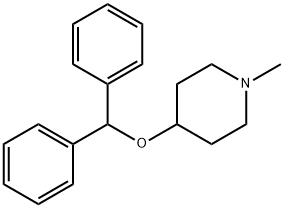CHEMICAL AND PHYSICAL PROPERTIES
| Physical Description | Solid |
|---|---|
| Melting Point | 206 |
| Solubility | 1.88e-02 g/L |
| LogP | 3.7 |
| Kovats Retention Index | 2073 2100 2101 2099 2085.6 2089.7 2098.7 2093.1 2099 |
COMPUTED DESCRIPTORS
| Molecular Weight | 281.4 g/mol |
|---|---|
| XLogP3 | 3.9 |
| Hydrogen Bond Donor Count | 0 |
| Hydrogen Bond Acceptor Count | 2 |
| Rotatable Bond Count | 4 |
| Exact Mass | 281.177964357 g/mol |
| Monoisotopic Mass | 281.177964357 g/mol |
| Topological Polar Surface Area | 12.5 Ų |
| Heavy Atom Count | 21 |
| Formal Charge | 0 |
| Complexity | 268 |
| Isotope Atom Count | 0 |
| Defined Atom Stereocenter Count | 0 |
| Undefined Atom Stereocenter Count | 0 |
| Defined Bond Stereocenter Count | 0 |
| Undefined Bond Stereocenter Count | 0 |
| Covalently-Bonded Unit Count | 1 |
| Compound Is Canonicalized | Yes |
PRODUCT INTRODUCTION
description
Diphenylpyraline is a member of the class of piperidines that is the benzhydryl ether derivative of 1-methyl-4-hydroxypiperidine. A sedating antihistamine, it is used as the hydrochloride for the symptomatic relief of allergic conditions including rhinitis and hay fever, and in pruritic skin disorders. It is also used as the teoclate salt (piprinhydrinate) as an ingredient in compound preparations for the symptomatic relief of coughs and the common cold. It has a role as a H1-receptor antagonist and a cholinergic antagonist. It is a member of piperidines and a tertiary amine.
